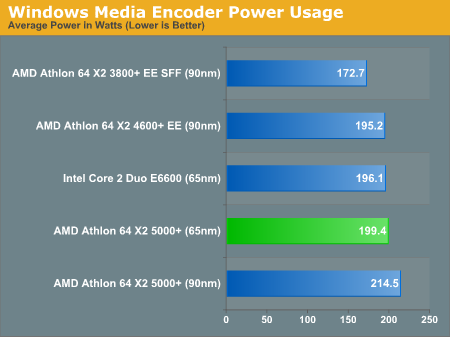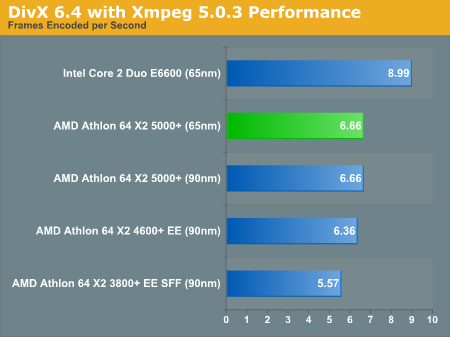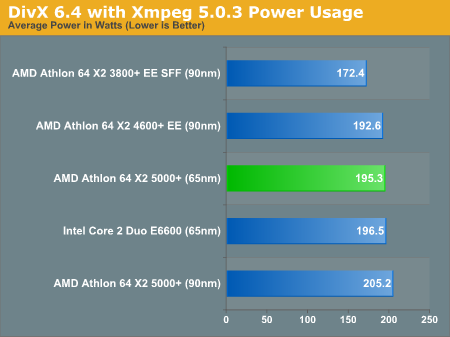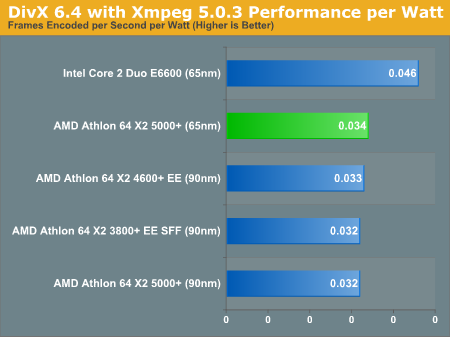AMD's 65nm Brisbane Core Previewed: The most energy efficient AMD CPU to date
by Anand Lal Shimpi on December 14, 2006 6:08 PM EST- Posted in
- CPUs
Media Encoding Performance & Power Consumption
In the interest of time we skipped our general application suites (SYSMark/Winstone) and dove directly into the individual application benchmarks to give us a more direct idea of how AMD's new 65nm chips will fare. We start off with our Windows Media Encoder test:

At the same price point, Intel is still faster with the E6600 as we've seen in the past, but what we're here mainly to do is to compare power usage, so let's see how Brisbane stacks up.

Power consumption is down from 90nm, as the 65nm system used about 15 fewer watts than its predecessor. The move to 65nm actually brings AMD in line with the power consumption of Intel's Core 2 Duo E6600, but it is still not enough to best the EE and EE SFF chips, the latter of which is rated at a cool 35W TDP.

Performance per watt is a different story; although AMD can compete with Intel in terms of power usage, it will take a new architecture to close the performance gap and thus performance per watt suffers in comparison to Core 2 Duo. The good news is that if we just look at the AMD CPUs in the performance per watt chart, it looks like the new 65nm processor offers better performance per watt than anything else in AMD's lineup - even the EE/EE SFF CPUs.
Moving on to our DivX test we see more of the same: the performance lead clearly goes to Intel's Core 2 Duo E6600:

Power usage is actually slightly lower on the 65nm AMD system than on the Core 2 Duo platform, and a bit lower than the 90nm X2 5000+ setup. The difference between 90nm and 65nm isn't huge here, a matter of just under 10W, but hopefully it's merely a sign of an early 65nm process compared to a more mature 90nm process.

The performance per watt crown still belongs to Intel, but if you look at AMD alone, Brisbane offers better efficiency than anything else in AMD's lineup.











63 Comments
View All Comments
dev0lution - Friday, December 15, 2006 - link
Now that both companies claim to offer "platforms" it'd be interesting to see an Intel 965 board vs. an ATI board being used in these benches. Not sure that the NVIDIA models were the best choice here, especially since their not apples to apples on generation and power consumption.poohbear - Thursday, December 14, 2006 - link
im quite shocked to see the gaming performance advantage @ 1600x1200!!!! is'nt the cpu removed as a performance bottle neck @ such a high resolution? its all about the gpu horsepower @ that resolution no? can't believe a cpu can show a 25fps diff @ 1600x1200?!?!?JumpingJack - Friday, December 15, 2006 - link
Some more research here is in order. The G80 GPU, commonly known as the 8800 GTX or GTS on the market, has taken graphics performance to a new level. All of the reviews that used an AMD FX-60 or 62 CPU clearly showed throttling back to the CPU in many if not most cases, only at the highest possible resolutions/AA + FSAA did the scaling turn back on with an FX-60. The X6800 released the full potential of this card.
The difference in framerate you see bettweent he 5000+ and the E6600 is that the E6600 is has pushed the bottleneck further ahead -- simply because the E6600 is a better gaming CPU.
Tom's did a good article titled: The 8800 Needs the Fasted CPU.
In essense, even for a single card solution, an AMD CPU is not a good match for this card.
Makaveli - Friday, December 15, 2006 - link
The reason for the 25fps difference must mean the Geforce is more cpu bottlenecked on the AMD platform than the intel one.U gotta remember the 8800GTX is an insanely fast card, and is still bottlenecked on Conroe systems.
JarredWalton - Friday, December 15, 2006 - link
This is why back at the Core 2 Duo launch we talked about CPU performance using games running at 1280x1024 0xAA. When a faster GPU comes out and shifts the bottleneck to the CPU (as has happened with the 8800 GTX), saying "Athlon X2 and Core 2 Duo are equal when it comes to gaming" is a complete fabrication. It's not unreasonable to think that there will be other games where that ~25% performance difference means you can enable high quality mode. Company of Heroes is another good example of a game that can chug on X2 chips at times, even with high-end GPUs.XMan - Thursday, December 14, 2006 - link
Do you think you might have gotten a higher overclock if you weren't running HTT at 1125MHz?!?Sunrise089 - Thursday, December 14, 2006 - link
The chart on page one claims to have pricing info. There is none as far as I can see.JarredWalton - Friday, December 15, 2006 - link
Fixed. :)RichUK - Thursday, December 14, 2006 - link
Same old sh!t. It's nice to see AMD finally kicking off their 65nm retail chips, but lets see this new core for God sakes.They're lacking big time, this really is sad. **Thumbs-Down**
Stereodude - Thursday, December 14, 2006 - link
How's a chip that uses less power run hotter? On the last page the 65nm X2 5000+ hit 51C under load, lower than any other chip, but it uses more power than any chip except the 90nm X2 5000+. How's that work?